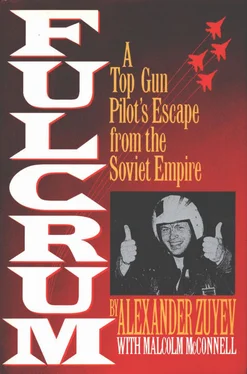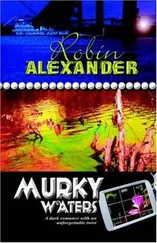With my left hand I slid back the throttles to idle and simultaneously squeezed the beavertail brake handle on the forward edge of the control stick with my right hand. The aircraft slowed at the end of the ramp. Working the nosewheel button, I allowed the residual momentum to swing the plane left onto the runway. The MiG-29 taxied as smoothly as it flew It was a true pilot’s airplane, and I was going to miss it. I stopped exactly midway between the white stripes marking the two-plane takeoff lane on the left side of Runway 09. In my right cockpit mirror, I saw Nikolai turn into the correct takeoff position behind me. His nose was forty-five feet right and seventy-five feet behind my right wingtip, close enough to follow my visual signals, but clear of my turbulent engine exhaust and wing vortices.
Here at Ruslan we kept radio communications to a minimum between planes in a formation and between aircraft and ground controllers. There were American electronic ferret satellites overhead constantly, sweeping the air for our radio transmissions. And this near the frontier with Turkey, the problem was even more acute. That mountain frontier only fifty miles to the south bristled with NATO electronic eavesdropping posts.
After the MiG-29 from the 2nd Squadron that had just landed cleared the runway, I swung my head in a wide arc, double-checking that the runway and landing approach were free of other aircraft. The takeoff light at the side of the runway flashed from red to green. The tower had cleared my flight for immediate departure. I knew everyone in the tower was watching us closely. Nikolai and I were in the 176th Frontal Aviation Regiment’s “Dogfight Masters” 1st Squadron. People expected to see a perfectly coordinated takeoff when we flew. And I certainly did not want to disappoint them today.
My left index finger went to the cockpit console beneath the throttles to set the flap button in the correct takeoff position. I waggled the control stick to move the horizontal stabilizers to get Nikolai’s attention. Then I pulled the stick back which tilted the leading edge down, the signal to Nikolai to advance throttles to 100 percent: full military power. I slid my own throttles open and waited the mandatory ten seconds for the whining turbofans to stabilize with equal RPM. Then I saw movement in my right cockpit mirror. Nikolai’s plane was beginning to slide forward, even though he had not released his brakes. I realized one of his wheels must have been on a slippery tar line between the concrete runway slabs, and the brakes could not hold. There was no way he could back up now, and we risked a sloppy, unprofessional takeoff.
This would not do on my last flight, not with all those people watching in the control tower. As I centered the stick to the neutral position, my right fingers popped the brakes, and I clamped my left hand on the spring-loaded throttle release and jammed the two throttle knobs full forward to afterburner. I was thrust back hard in my seat by an invisible piston of acceleration. Cones of flame now pulsed from the twin tail pipes, producing over 36,600 pounds of thrust. With my fuel load today, the aircraft had a positive thrust-to-weight ratio. The rear of my helmet sagged into the hard padding at the top of the ejection seat.
The triple row of broken, white runway lane stripes flew by in a blur. By going to afterburner, I had kept ahead of Nikolai. In my mirror his plane was pegged in the correct position behind me on the runway. My helmet thrust harder into the seat cushion, and I felt myself grinning inside my oxygen mask. By a lucky quirk, this last takeoff was going to be on afterburner, one of the most powerful experiences a fighter pilot enjoyed. As always on afterburner takeoff’s, rock music seemed to echo in my head. Today it was the crashing rhythms of the Rolling Stones.
My airspeed hit 100 knots and I pulled the stick back gently to rotate the nose. One second later we were at 135 knots, and the main gear lifted clear of the runway. This was a critical moment on an afterburner takeoff. The hinged, perforated screens protecting the engine air inlets had been in the down, closed position. During taxi and takeoff, engine air was fed through inlets on the leading-edge wing extensions below the cockpit. These louvered ducts in the gray tapered skin of the fighter always reminded me of the gills behind the streamlined head of a deep-ocean shark. At rotation speed the engine airflow was transferred from these upper inlets back to the main lower intakes as the protective screens automatically retracted. The sudden aerodynamic shift always caused a nose-down swing, which I had to parry with the trim button on the stick.
I retracted gear and pitched the nose up sharply to a fifty-degree climb. As the altitude and airspeed increased, I raised the flaps and glanced back in the mirror to find Nikolai’s aircraft. He had lifted off in perfect position behind me. I could see his left hand raised thumbs-up to show his appreciation at my quick response in going to afterburner.
Still on the burners, I banked left and leveled off at precisely 13, 500 feet and a heading of 270 degrees, due west toward our training zone, thirty miles away over the Black Sea. Now I throttled back and trimmed for an airspeed of 350 knots. Although this altitude was reserved for westbound traffic, it was always smart to keep your eyes open around a military airfield. The MiG-29’s cockpit, perched high and well forward on the nose, provided great visibility. And today the view was spectacular.
The layout of the Ruslan Air Base below was typical of Soviet fighter regiments. Hangar and maintenance facilities and the pilots’ ready room were strung out along the parking apron that ran on an oblique angle to the runway. I could see the regiment’s aircraft parked in pairs along that apron. Regimental headquarters was near the far eastern end of the runway, a good twenty-minute walk from the squadron areas. There were two control towers near the western end of the runway, one to handle air traffic, the other for the engineering and maintenance section.
The duty-alert building, which had its own small dormitory and dining room, stood close to the air traffic control tower There were four fully fueled and armed duty-alert aircraft parked separately just inside the taxi ramp. Normally the alert planes were parked on their own apron right beside the duty-alert building. But that apron had been ripped up for repaving, a repair that could take months, using lazy, inefficient Stroybat construction troops.
In principle, the alert section could be airborne within five minutes of an order to scramble, in half that time if the pilots had been pre-alerted and were ready in the cockpit waiting to start engines.
The explosive ordnance and missile maintenance shops were also near that end of the runway. Both the PPR missile shop and the RTB nuclear weapons storage and assembly sites stood within their own guarded compounds. The RTB facility was surrounded by a high wall capped with barbed wire and guarded by a separate contingent of troops who reported directly to the Strategic Forces Command in Moscow.
I gazed down at the familiar scene I would probably never see again. The base arrangement was designed to efficiently facilitate flight operations. Given this widely dispersed layout, however, nonflight operations — the mundane bureaucratic housekeeping chores of military life — were often inconvenient. From this altitude I could still make out the clunking old bus on its infrequent circuit of the base. It was turning onto the main road to the officers’ housing complex a mile and a half away. Usually the rickety bus was out of service because of a lack of spare parts or the terrible maintenance habits of the conscript soldiers responsible for it.
Division regulations prevented officers with their own cars from driving on the base because some might steal fuel. Fat chance. No one wanted the base gas. One of our staff officers was a true Socialist “entrepreneur” He stole so much gasoline and watered it down with TS-1 jet fuel kerosene that the stuff couldn’t be safely used in a car. So we often had to ride bicycles or waste time walking when we were summoned from the ready room to regimental headquarters or took our turn in the simulators.
Читать дальше










